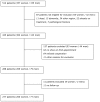Risk of falling in patients with a recent fracture
- PMID: 17598891
- PMCID: PMC1933426
- DOI: 10.1186/1471-2474-8-55
Risk of falling in patients with a recent fracture
Abstract
Background: Patients with a history of a fracture have an increased risk for future fractures, even in short term. The aim of this study was to assess the number of patients with falls and to identify fall risk factors that predict the risk of falling in the first three months after a clinical fracture.
Methods: Prospective observational study with 3 months of follow-up in a large European academic and regional hospital. In 277 consenting women and men aged > or = 50 years and with no dementia and not receiving treatment for osteoporosis who presented to hospital with a clinical fracture, fall risk factors were assessed according to the guidelines on fall prevention in the Netherlands. Follow-up information on falls and fractures was collected by monthly telephone interview. Incidence of falls and odds ratio's (OR, with 95% confidence intervals) were calculated.
Results: 512 consecutive patients with a fracture were regarded for analysis, 87 were not eligible for inclusion and 137 patients were excluded. No follow-up data were available for 11 patients. Therefore full analysis was possible in 277 patients.A new fall incident was reported by 42 patients (15%), of whom five had a fracture. Of the 42 fallers, 32 had one new fall and 10 had two or more. Multivariate analysis in the total group with sex, age, ADL difficulties, urine incontinence and polypharmacy showed that sex and ADL were significant fall risk factors. Women had an OR of 3.02 (95% CI 1.13-8.06) and patients with ADL-difficulties had an OR of 2.50 (95% CI 1.27-4.93). Multivariate analysis in the female group with age, ADL difficulties, polypharmacy and presence of orthostatic hypotension indicated that polypharmacy was the predominant risk factor (OR 2.51; 95% CI: 1.19 - 5.28). The incidence of falls was 35% in women with low ADL score and polypharmacy compared to 15% in women without these risk factors (OR 3.56: CI 1.47 - 8.67).
Conclusion: 15% of patients reported a new fall and 5 patients suffered a new fracture within 3 months. Female sex and low ADL score were the major risk factors and, in addition, polypharmacy in women.
Figures
References
-
- Gillespie LD, Gillespie WJ, Robertson MC, Lamb SE, Cumming RG, Rowe BH. Interventions for preventing falls in elderly people. Cochrane Database Syst Rev. 2003:CD000340. - PubMed
-
- Tinetti ME, Speechley M, Ginter SF. Risk factors for falls among elderly persons living in the community. N Engl J Med. 1988;319:1701–1707. - PubMed
MeSH terms
LinkOut - more resources
Full Text Sources
Medical


